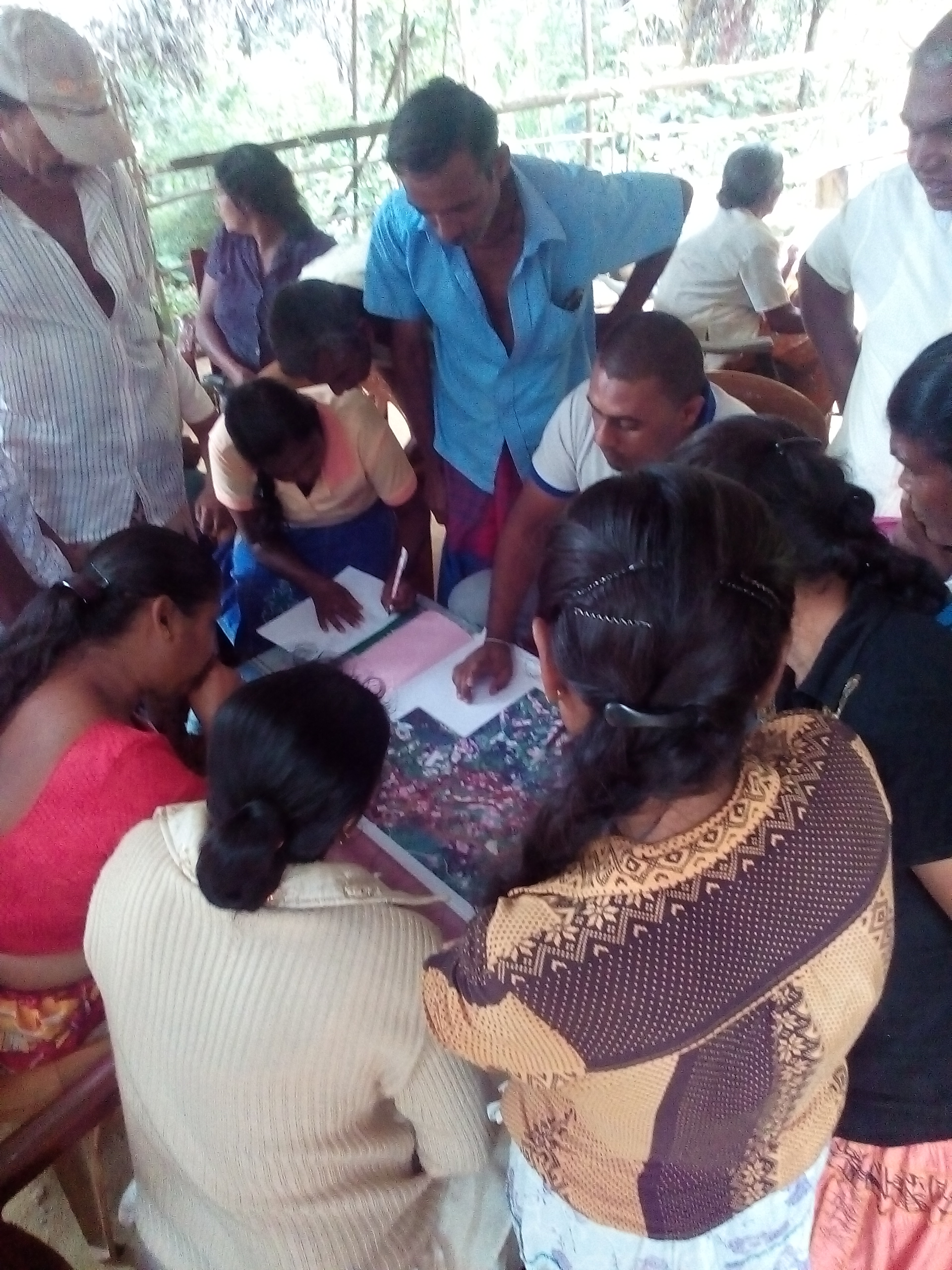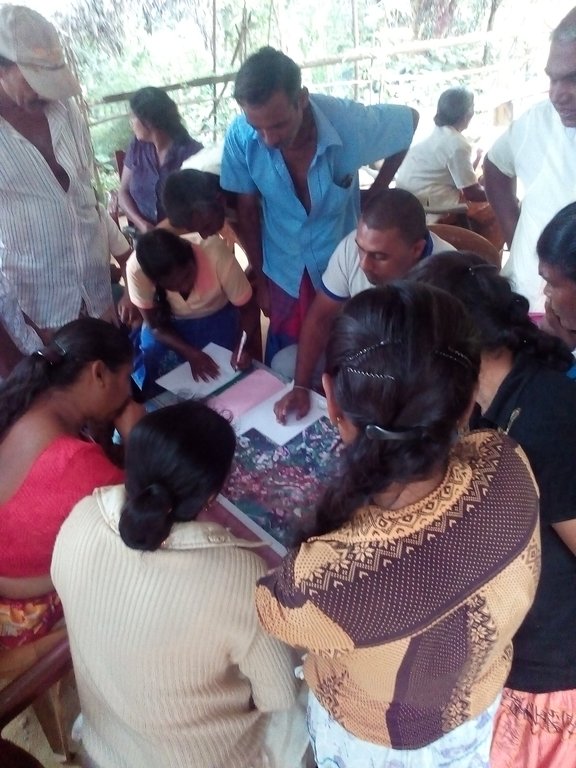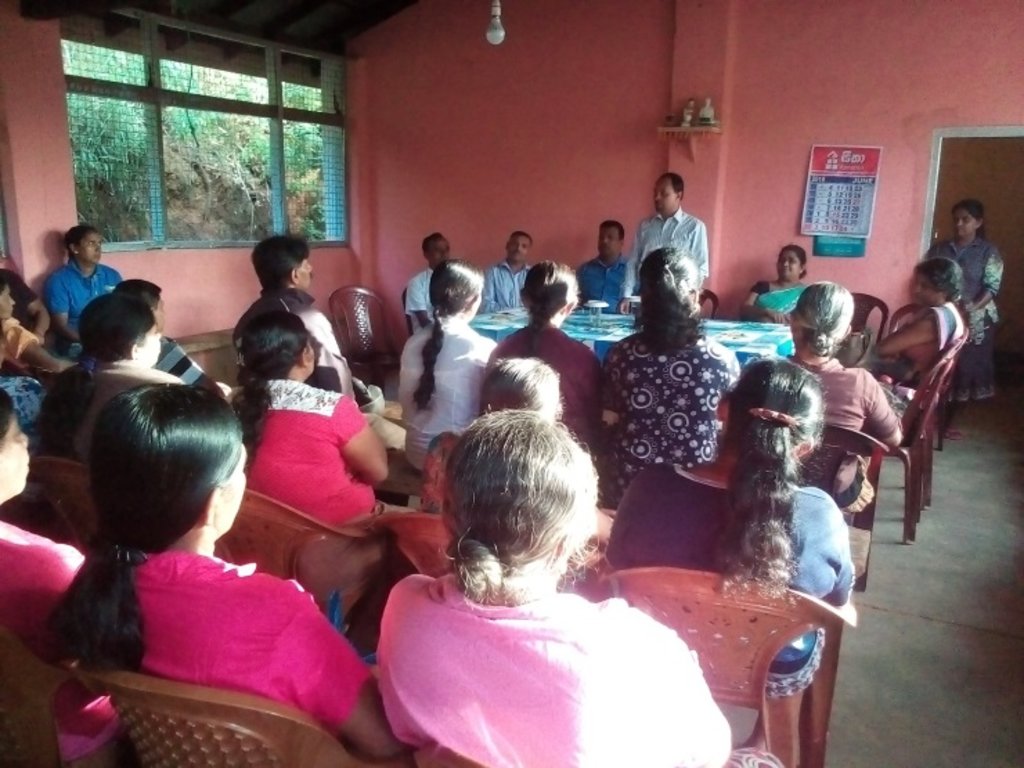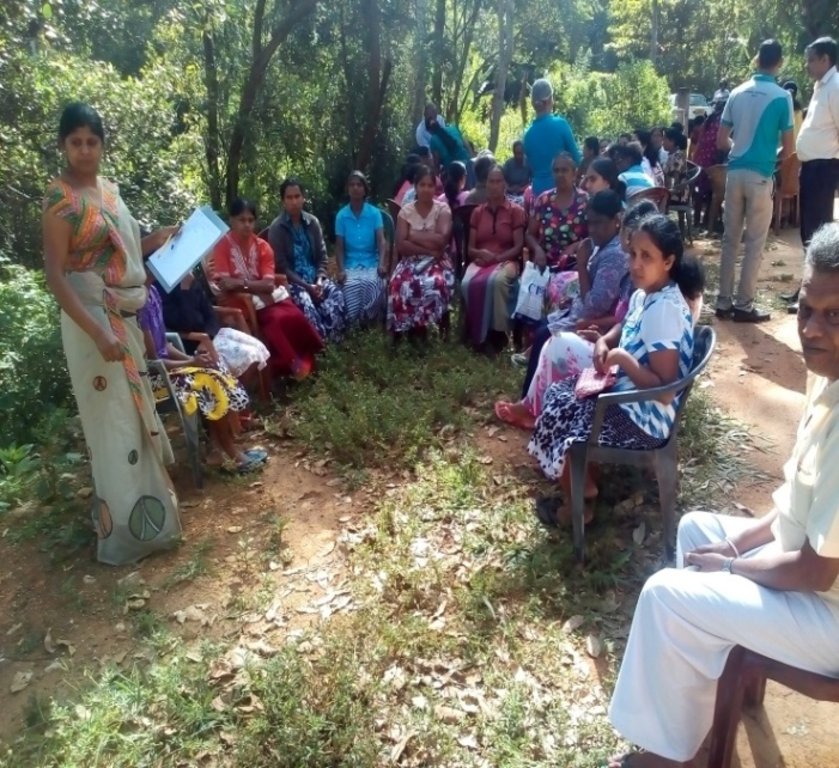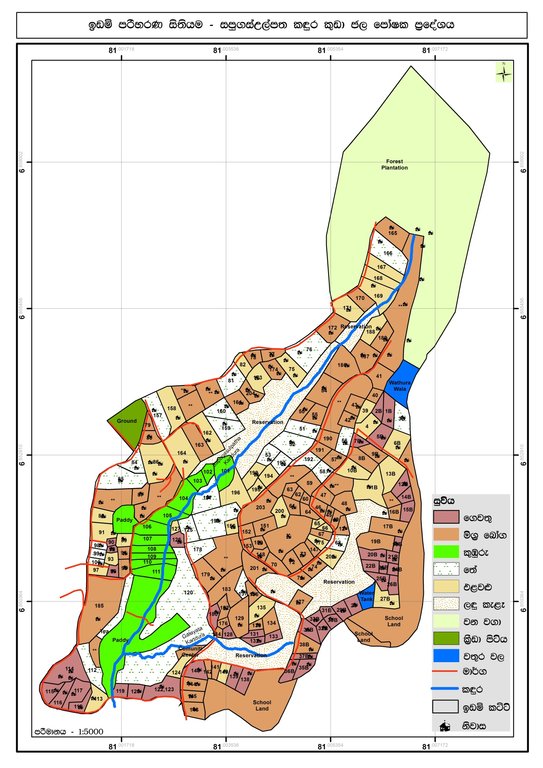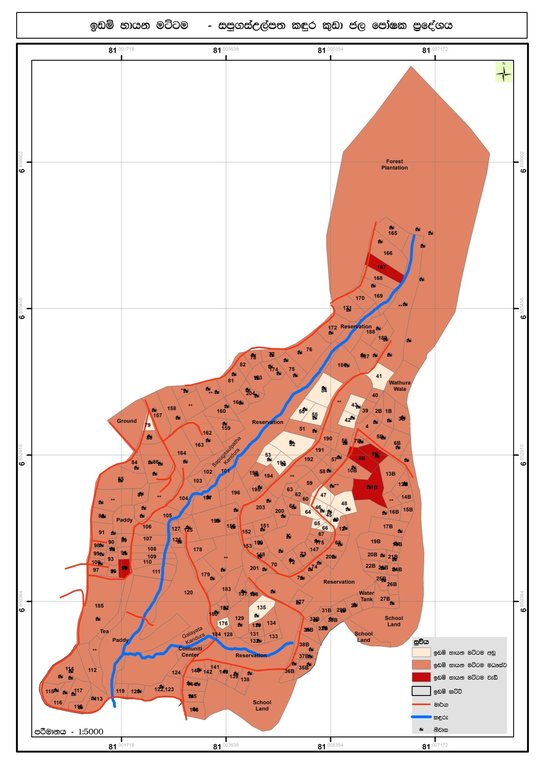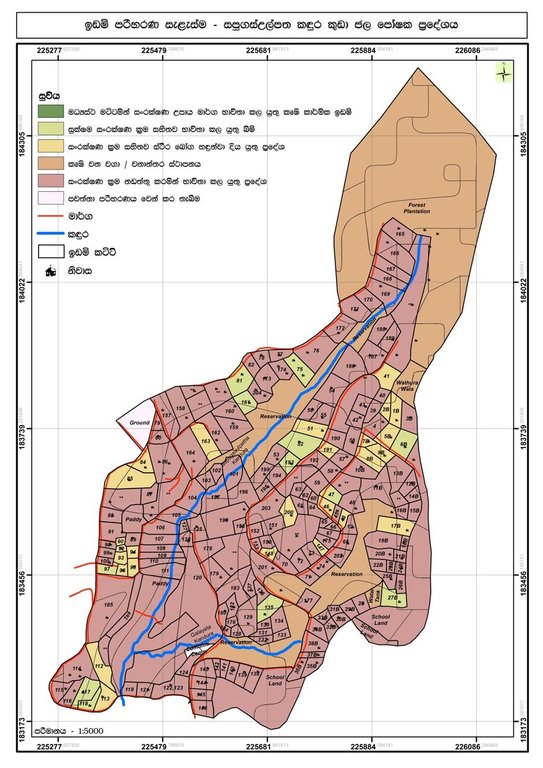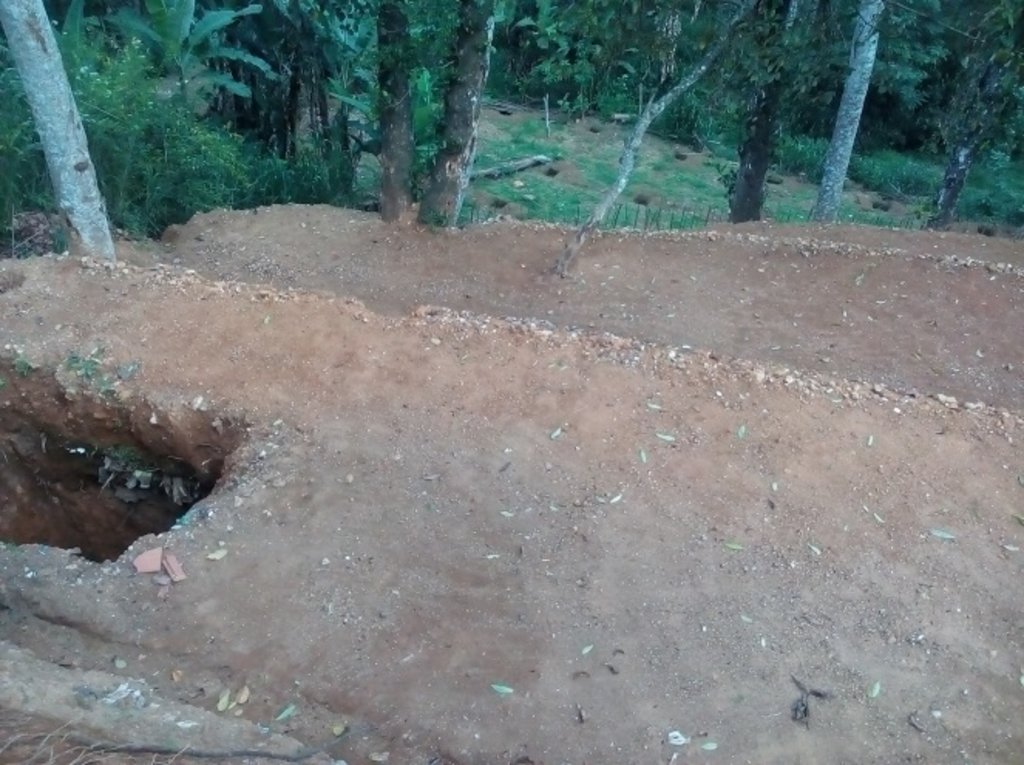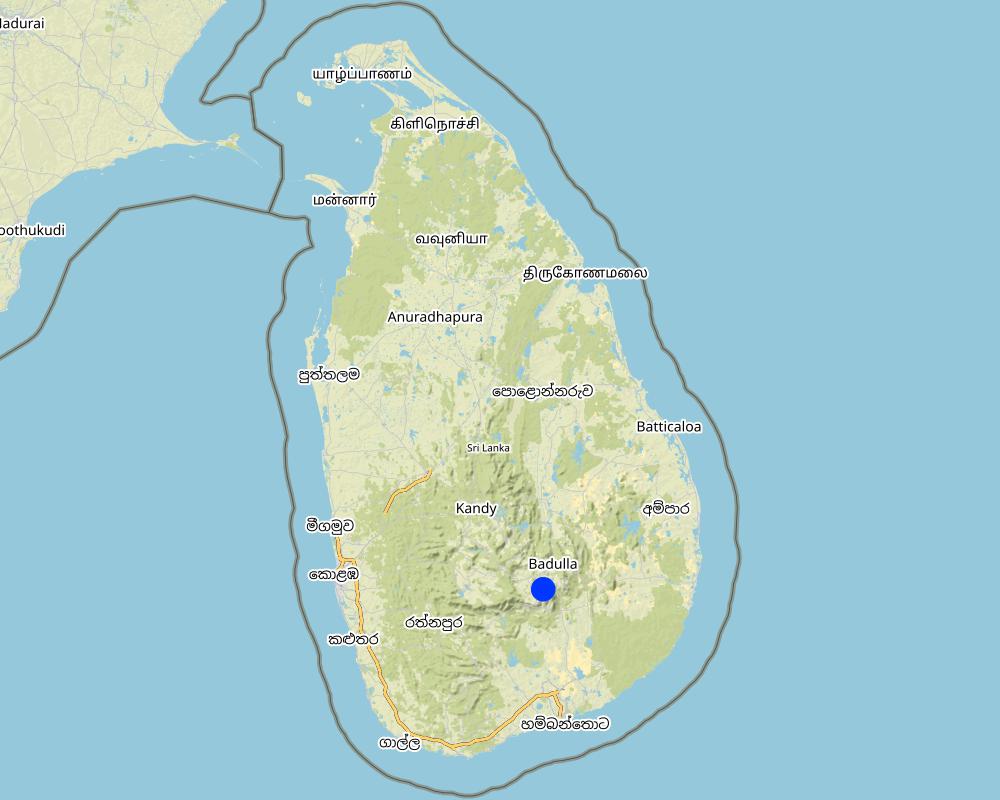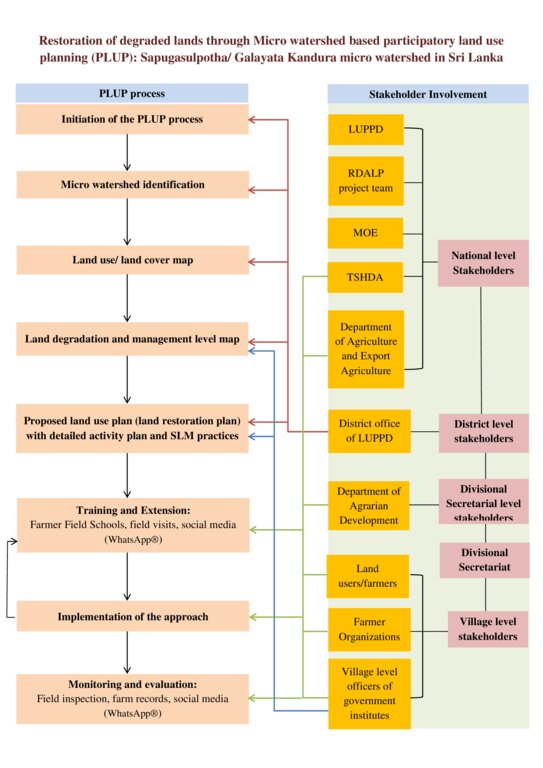Restoration of degraded lands through participatory land use planning [Sri Lanka]
- Criação:
- Atualização:
- Compilador/a: Head Soil Science
- Editor: –
- Revisores: William Critchley, Rima Mekdaschi Studer
Village-based participatory land use planning
approaches_6237 - Sri Lanka
Veja as seções
Expandir tudo Recolher tudo1. Informação geral
1.2 Detalhes do contato das pessoas capacitadas e instituições envolvidas na avaliação e documentação da abordagem
co-compiler:
co-compiler:
Agrarian Research and Production Assistant:
Karunarachchi Mangalika
+94714955038
Department of Agrarian Development
Agrarian Research and Production Assistant Office, Galayata Kandura, Bindunuwewa, Bandarawela.
Sri Lanka
usuário de terra:
Podimenike W.M.
+94572232842
Galayata Kandura, Bindunuwewa, Bandarawela.
Sri Lanka
Nome do projeto que facilitou a documentação/avaliação da Abordagem (se relevante)
Rehabilitation of Degraded Agricultural Lands in Kandy, Badulla and Nuwara Eliya Districts in the Central Highlands of Sri LankaNome da(s) instituição(ões) que facilitou(ram) a documentação/avaliação da Abordagem (se relevante)
Faculty of Agriculture, University of Peradeniya, Sri Lanka (AGRI.PDN) - Sri Lanka1.3 Condições em relação ao uso da informação documentada através de WOCAT
Quando os dados foram compilados (no campo)?
24/02/2022
O compilador e a(s) pessoa(s) capacitada(s) aceitam as condições relativas ao uso de dados documentados através do WOCAT:
Sim
2. Descrição da abordagem de GST
2.1 Descrição curta da abordagem
Microwatershed-based participatory land use planning is a systematic and interactive process that primarily focuses on the optimal allocation of village land resources according to needs and demands of the people while promoting sustainable land management. Key features of this approach are multi-sectoral coordination, multi-stakeholder engagement and the active participation of land users throughout the participatory land use planning process.
2.2 Descrição detalhada da abordagem
Descrição detalhada da abordagem:
The Sapugasulpatha/ Galayata Kandura microwatershed is located in Bandarawela Divisional Secretariat (DS), Badulla District, Sri Lanka. Unsustainable land management has led to land degradation causing associated challenges. There was a need to identify strategies for restoration of degraded lands while addressing water scarcity. In 2018, the Rehabilitation of Degraded Agricultural Lands Project (RDALP) introduced participatory land use planning (PLUP) for this microwatershed. Previously, stakeholders were dealt with individually. But the PLUP process relies on the active involvement of all stakeholders. Key is microcatchment level planning - embedded in multi-sectoral coordination and multi-stakeholder engagement.
The process is initiated by the district office of the Land Use Policy Planning Department (LUPPD). Firstly, the LUPPD identifies microwatersheds and develops land use/cover maps. It is assisted by the Bandarawela DS, which is the administrative body for lands in the area and has the capacity to coordinate all relevant stakeholders. Then, officers of the LUPPD meet with community leaders, representatives of farmer organizations and field level officers to verify the land use maps through field visits. Demarcation of individual plots on these maps is also carried out. Next, a field visit is conducted with all stakeholders to identify the status of land degradation and the current crop management practices. This is, effectively, “training of trainers”. Subsequently, the community prepares maps of land degradation and management types with the support of LUPPD.
This is followed by a participatory rural appraisal (PRA) process with all stakeholders. In the PRA, issues related to land degradation/use, ownership, conflicts and socio-economic concerns are discussed. Participants come to an initial consensus on solutions. After this, a detailed action plan is prepared and stakeholders identified. The next stage involves the development of land use plans for the entire microwatershed targeting the restoration of degraded and poorly managed lands. The land use plan covers both on-farm and off-farm land, and provides recommendations for SLM practices over the entire microwatershed: it serves as a detailed land restoration plan. Then, detailed discussions are held with specific stakeholders to prepare sector-based plans. This includes detailed plans for individual farms. As an example, officers of Tea Smallholdings Development Authority (TSHDA) provide inputs to develop detailed plans for smallholder tea cultivation - including plans for individual farmers. Subsequently, implementation is performed jointly by stakeholders. If, for example, a farm is identified for tea cultivation intercropped with export crops, officers both from TSHDA and the Department of Export Agriculture extend their support. The approach includes farmer field schools (FFS) conducted by the Department of Agrarian Development officers and project officers of RDALP. Moreover, farmers are encouraged to use social media (WhatsApp®) to share their knowledge and experiences with SLM practices. The local community is also exposed to examples of good SLM through field visits. The final step is evaluation and monitoring. This is performed by the officers of the Agrarian Service Development, RDALP, and also by individuals. A divisional agricultural committee is mandated to perform continuous monitoring of implementation. PLUP provides the stimulus for farmers to continue SLM - since practices are not enforced but identified themselves. Further, firm bonding is established between land users and other stakeholders, including government institutes, strengthening the likelihood of sustainability.
2.3 Fotos da abordagem
2.4 Vídeos da abordagem
Comentários, breve descrição:
https://youtu.be/uHBRGYVT--M
Participatory Land Use Planning for Sustainable Land Management
Data:
03/08/2021
Localização:
Dambugasagala, Welimada
2.5 País/região/locais onde a abordagem foi aplicada
País:
Sri Lanka
Região/Estado/Província:
Badulla District - Uva province
Especificação adicional de localização:
Watagamuwa Grama Niladhari Division, Bandarawela Divisional Secretariat Division
Map
×2.6 Datas de início e término da abordagem
Indique o ano de início:
2018
Ano de término (caso a abordagem não seja mais aplicada):
2021
Comentários:
Stakeholders continue to provide extension service for this microwatershed, even though the project was finished.
2.7 Tipo de abordagem
- Baseado em projeto/programa
2.8 Principais metas/objetivos da abordagem
1)Identification and mapping of degraded lands at microwatershed level.
2)Integration of multi-sectoral coordination and multi-stakeholder engagement in participatory land use planning implemented at village micro watershed level.
3)Identification of land management related issues and factors contributing to land degradation and prioritizing sustainable land use/management options through participatory approach.
4)Development and implementation of a land use plan and an action plan to restore and mitigate the degradation within the micro watershed employing PLUP approach.
5)Maintenance and promotion of ecosystem services for the sustainability of rural livelihoods.
6)Reduction of the pressure of competitive land use on natural resources.
2.9 Condição que propiciam ou inibem a implementação de tecnologia/tecnologias aplicada(s) segundo a abordagem
Normas e valores sociais/culturais/religiosos
- Propício
Greater social capital as local community is well organized with a strong social bonding among villagers. Farmer organization with leaders appointed by villagers further strengthened the bonding between people for agriculture/ land management related activities.
- Inibitivo
Lack of interest of young generation on farming.
Disponibilidade/acesso a recursos e serviços financeiros
- Propício
Having access to a comprehensive land use plan for each land increases access for financial resources such as loan facilities from banks, subsidy schemes of TSHDA, Loan facilities of tea factories. Farmers have the option to come with an agreement with a leading supermarket chain in Sri Lanka to obtain financial services/materials with the promise of supplying the products exclusively to the said supermarket chain.
- Inibitivo
Existing financial wellbeing of farmers and land ownership related issues limits the access.
Quadro institucional
- Propício
National, regional and village level institutional set up is existing. Moreover, farmer organizations have strengthened the collective power of farmers to coordinate with institutes. Female farmers have formed “Sithamu” Women's Farmers' Organization and both female and male farmers in the village have formed “Galayata Kandura” Rural Farmer Organization. Land use plan serves as a common platform for the collaboration between institutes enhancing the overall synergy.
- Inibitivo
Often the lack of coordination between sectoral institutes and top-down approach in decision making. Lack dedicated institutes to coordinate activities at national level.
Colaboração/coordenção de atores
- Propício
Officers of relevant government institutes namely, DS, LUPPD, Extension service of the Department of Agriculture, Department of Agrarian Development, Department of Export Agriculture and TSHDA are willingly to support farmers. Moreover, RDALP project officers play an important role in coordinating the activity.
Quadro jurídico (posse de terra, direitos de uso da terra e da água)
- Propício
Majority of farmers own their lands (home gardens and tea smallholdings). Legal frameworks of land ownership and land and water usage are well established.
- Inibitivo
Delays and complications in solving legal issues pertaining to land use
Políticas
- Propício
Land use policy, soil conservation act, national action plan (NAP) to combat land degradation
- Inibitivo
Lack of implementation of policies and acts
Governança da terra (tomada de decisões, implementação e aplicação)
- Propício
Presence of land use committee (at divisional level) and divisional agriculture committee (included all government institutes related to land use) for decision making. The DS is the chairperson of these committee who is also a part of the PLUP process. Farmers have the liberty to take land use decisions within the framework of land use policy and administrative framework. However, field level officers representing government institutes such as LUPPD, Department of Agriculture, Department of Export Agriculture, TSHDA play a supporting role in implementation of these decisions. Absence of Gender biasedness is a very important factor.
- Inibitivo
Land ownerships, conflicts on land ownership, illegal encroachment of sensitive areas of the micro watershed and political interferences
Conhecimento sobre GST, acesso a suporte técnico
- Propício
Farmer organizations serve as a platform to share knowledge on SLM. Strong village level extension service is facilitated by the Department of Agriculture, Export Agriculture, TSHDA and other technical services. These officers are available at Agrarian Service Centre and Wednesdays are allocated for meeting with farmers. Moreover, conducting field visits is a part of their duty. Farmer groups have been identified and introduced social media platforms such as WhatsApp® to share SLM knowledge by experts and among themselves. Farmers are capable of operating online interaction facilities such as Zoom® allowing experts to share the knowledge conveniently.
- Inibitivo
Inadequacy of extension officers
Mercados (para comprar entradas, vender produtos) e preços
- Propício
Farmers have the choice of marketing their products and enter into the value chain i.e. direct selling at the village vegetable market, private companies those visit to the field for purchasing their products (vegetable, spice crops and tea) and intermediate buyers. Farmers also have the option to come into a contract with a leading supermarket chain to sell their products if they are willing to adopt Good Agricultural Practices (GAP).
- Inibitivo
Lack of transport facilities, low market price offered by intermediate buyers, price fluctuations
Carga de trabalho, disponibilidade de força de trabalho
- Propício
Most of the SLM practices which are promoted through this approach are not very labor-intensive. Often, family members are sufficient to establish the majority SLM practices.
- Inibitivo
Lack of labor force due to the labor migration
3. Participação e papel das partes interessadas envolvidas
3.1 Partes interessadas envolvidas na abordagem e seus papéis
- Usuários de terra/comunidades locais
Land users/ village farmers (both men and women)
Express their willingness to involve in PLUP. They are involved in the entire process by actively participating for group discussions and activities with other stakeholders to identify land use related issues, prepare a community land use plan, identify SLM practices and implementation. Further, participation for training programmes and share the knowledge about SLM practices.
- Organizações comunitárias
“Sithamu” Women's Farmers' Organization and “Galayata Kandura" Rural Farmer Organization
All farmers of the village are members of these community based organizations. These serve as a platform to promote the involvement of farmers in the PLUP process. Moreover, problems/issues arise in the process are discussed within the organization to come up with socially agreed solutions.
- Especialistas em GST/ consultor agrícola
LUPPD, Department of Agriculture, Department of Export Agriculture, Department of Agrarian Development, TSHDA
Identification of village level micro-catchments by LUPPD
Introducing SLM technologies
Provision of training
Oversee the implementation and monitoring the success of field adopted SLM technologies
- Governo local
DS office of Bandarawela, Department of Agrarian Development, TSHDA, Department of Agriculture and Department of Export Agriculture
Involved in the PLUP process as key stakeholders responsible for advisory services, conflict resolution, capacity building and overall implementation and monitoring
- Governo nacional (planejadores, responsáveis pelas decisões)
LUPPD, Ministry of Environment (MOE), Natural Resource Management Centre of the Department of Agriculture
Support the preparation of land use plans within the context of legal frame work of the country
- Organização internacional
Food and Agriculture Organization (FAO), Global Environment Facility (GEF)
Project coordination, partial financial support, Capacity building
Caso várias partes interessadas foram envolvidas, indique a agência líder:
LUPPD
3.2 Envolvimento do usuários de terra/comunidades locais nas diferentes fases da abordagem
| Envolvimento do usuários de terra/comunidades locais | Especifique quem estava envolvido e descreva as atividades | |
|---|---|---|
| Iniciação/motivação | Participativo | Community leaders, LUPPD, DS and RDAL Project officers. The process is initiated by the district office of LUPPD which is the responsible national level authority to prepare sustainable land use plans. The regional office identifies village level micro catchment and develop land use/cover maps. The DS serves as a body that coordinate the activity by linking relevant stakeholders. |
| Planejamento | Participativo | Community leaders, land users, LUPPD, DS and RDALP officers. Planning of the PLUP process is performed by these parties. |
| Implementação | Participativo | Land users, community leaders, Department of Agrarian Development, Department of Agriculture, Department of Export Agriculture, TSHDA, officers of RDALP, other officers representing different agriculture sectors and land users. Implementation of the restoration plan for individual farm is performed jointly by different stake holders. As an example if a farmers` land is identified for tea cultivation intercropped with export agricultural crops, officers both from TSHDA and Department of Export Agriculture extend their support for implementation. |
| Monitoramento/avaliação | Participativo | Land users, Department of Agrarian Development, RDALP officers, individual stakeholders, Department of Agriculture, officers of Natural Resource management Centre and divisional agricultural committee. Please note that participatory monitoring mechanism was implemented. |
| Marketing | Automobilização | Land users (farmers), private companies and intermediate sellers. Farmers have the choice of marketing their products by direct selling at the village vegetable market, through private companies those visit to the field for purchasing their products (vegetable and tea) and intermediate buyers. Moreover, farmers also have the option to come into a contract with a leading supermarket chain to sell their products if they are willing to adopt Good Agricultural Practices (GAP) |
3.3 Fluxograma (se disponível)
Descrição:
The PLUP described above is focused on restoration of degraded lands at microwatershed level. The multi-sectoral coordination and multi-stakeholder engagement throughout the process are key features of this process leading to the preparation of detailed restoration plan at on-farm and off-farm levels promoting sustainable land management.
Autor:
Prof. W.A.U. Vitharana
3.4 Decisão sobre a seleção de tecnologia/tecnologias de GST
Especifique quem decidiu sobre a seleção de tecnologia/tecnologias a serem implementadas:
- todos os atores relevantes, como parte de uma abordagem participativa
Explique:
This is a participatory approach in which stakeholders make collective decisions on the selection of appropriate technologies. Multi-stakeholder engagement is a prominent characteristic.
Especifique em que base foram tomadas as decisões:
- Avaliação de conhecimento bem documentado de GST (tomada de decisão baseada em evidências)
- Resultados de pesquisa
- Experiência pessoal e opiniões (não documentado)
4. Suporte técnico, reforço das capacidades e gestão do conhecimento
4.1 Reforço das capacidades/formação
Foi oferecida formação aos usuários da terra/outras partes interessadas?
Sim
Especifique quem foi capacitado:
- Usuários de terra
- Equipe de campo/consultores
Caso seja relevante, especifique gênero, idade, status, etnia, etc.
Training was provided for both men and women farmers of the microwatershed
Tipo de formação:
- Agricultor para agricultor
- Áreas de demonstração
- Reuniões públicas
Tipo de formação:
- social media (WhatsApp®) and online meetings via Zoom® platform
Assuntos abordados:
Sustainable Land Management practices, compost preparation, liquid fertilizer preparation, water harvesting techniques, soil conservation practices and pruning of fruit trees
Comentários:
Farmers have shown a great interest on sharing knowledge and experiences through the social media
4.2 Serviço de consultoria
Os usuários de terra têm acesso a um serviço de consultoria?
Sim
Especifique se foi oferecido serviço de consultoria:
- nas áreas dos usuários da terra
- Em centros permanentes
Descreva/comentários:
Well organized advisory service is available in Sri Lanka which is conducted through the field officers of the Department of Agriculture, Export Agriculture, TSHDA. These officers are available at Agrarian Service Centre and Wednesdays are allocated for meeting with farmers and making field visits is a part of their job. Moreover, members of the project team RDALP also served as trainers. Importantly, community leaders and farmer organization representatives were trained as trainers to assure the sustainability.
4.3 Fortalecimento da instituição (desenvolvimento organizacional)
As instituições foram fortalecidas ou estabelecidas através da abordagem?
- Sim, moderadamente
Especifique a que nível (níveis) as instituições foram fortalecidas ou estabelecidas:
- Local
- Regional
Descreva instituição, papéis e responsabilidades, membros, etc.
The PLUP process strengthens the institutional coordination and their roles at village level.
Especifique o tipo de apoio:
- Financeiro
- Reforço das capacidades/formação
- Equipamento
- infrastructure
Dê mais detalhes:
Details are provided in Table 6.3
4.4 Monitoramento e avaliação
Monitoramento e avaliação são partes da abordagem?
Sim
Comentários:
Field level government officers are entrusted with the monitoring process with the participation of land users
Caso afirmativo, esta documentação é destinada a ser utilizada para monitoramento e avaliação?
Não
4.5 Pesquisa
A pesquisa foi parte da abordagem?
Não
5. Financiamento e apoio material externo
5.1 Orçamento anual para o componente de GST da abordagem
Caso o orçamento exato seja desconhecido, indique a faixa:
- 10.000-100.000
Comentários (p. ex. principais fontes de recursos/principais doadores):
GEF and local government institutions
5.2 Apoio financeiro/material concedido aos usuários da terra
Os usuários da terra receberam apoio financeiro/material para a implementação de tecnologia/tecnologias?
Sim
Caso afirmativo, especifique tipo(s) de apoio, condições e fornecedor(es):
Financial support for soil conservation, materials for preparation of nursery sheds (4x4 feet), vegetable seeds and fruit plants for home gardening, tea seedlings for infilling and polythene for rain water harvesting ponds
5.3 Subsídios para entradas específicas (incluindo mão-de-obra)
- Mão-de-obra
| Em que medida | Especifique os subsídios |
|---|---|
| Parcialmente financiado | Subsidy for establishment of soil conservation structures |
- Equipamento
| Especifique quais entradas foram subsidiadas | Em que medida | Especifique os subsídios |
|---|---|---|
| Maquinário | Totalmente financiado | Pruning kits for fruit tree management, Portable hole drilling machine* for establishment of tea plantations, Bush cutters*, selective plucking machines. *Provided for the Village farmer society |
| Ferramentas | Totalmente financiado | Nursery trays |
- Agrícola
| Especifique quais entradas foram subsidiadas | Em que medida | Especifique os subsídios |
|---|---|---|
| Sementes | Totalmente financiado | Vegetables seeds |
| Fruit plants, Tea seedlings | Totalmente financiado | Fruit plants for home gardening and intercropped with tea, tea seedling for infilling |
- Construção
| Especifique quais entradas foram subsidiadas | Em que medida | Especifique os subsídios |
|---|---|---|
| UV treated Polyethene | Totalmente financiado | UV treated Polyethene for water harvesting ponds and nursery sheds |
- Infraestrutura
| Especifique quais entradas foram subsidiadas | Em que medida | Especifique os subsídios |
|---|---|---|
| Rainwater storage tank | Totalmente financiado | Rainwater storage tank to harness water for micro watershed and the downstream areas as ground water |
Se a mão-de-obra pelos usuários da terra foi uma entrada substancial, isso foi:
- Voluntário
Comentários:
Most of the time family members are engaged with field activities
5.4 Crédito
Foi concedido crédito segundo a abordagem para atividades de GST?
Não
5.5 Outros incentivos ou instrumentos
Foram utilizados outros incentivos ou instrumentos para promover a implementação das tecnologias de GST?
Sim
Caso afirmativo, especifique:
Land use policy and agriculture policy of Sri Lanka are overarching instruments. Moreover, regulations identified in the Soil Conservation Act of Sri Lanka promote SLM technologies.
6. Análise de impactos e declarações finais
6.1 Impactos da abordagem
A abordagem concedeu autonomia aos usuários locais de terra, melhorou a participação das partes interessadas?
- Não
- Sim, pouco
- Sim, moderadamente
- Sim, significativamente
All land users are part of the approach which empowered land users on knowledge on land degradation, SLM practices and preparation of detailed restoration plan for degraded/poorly management lands. Moreover, training programs and field visits empowered land users with specific skills.
A abordagem propiciou a tomada de decisão baseada em evidências?
- Não
- Sim, pouco
- Sim, moderadamente
- Sim, significativamente
The participatory approach includes field visits, analysis of field evidences to identify degraded lands and lands those have not been properly managed. These allow land users on evidence based decision making to implement SLM practices.
A abordagem auxiliou os usuários da terra a implementar e manter as tecnologias de GST?
- Não
- Sim, pouco
- Sim, moderadamente
- Sim, significativamente
The entire process help land users to understand user specific sustainable land management options and also integrate local knowledge and experience. Since SLM options are identified by land users it enables them to implement based on available resources. Involvement relevant stakeholders (e.g. Agriculture extension officers) and training programs help land users for the implementation and maintenance of SLM technologies. Partial financial support and material support further help farmers to implement and maintain SLM practices.
A abordagem melhorou a coordenação e a implementação economicamente eficiente da GST?
- Não
- Sim, pouco
- Sim, moderadamente
- Sim, significativamente
Multi-sectoral coordination embedder throughout the process improve coordination among stakeholders. The SLM practices which are identified by land users assured to be cost-effective and manageable.
A abordagem mobilizou/melhorou o acesso aos recursos financeiros para implementação da GST?
- Não
- Sim, pouco
- Sim, moderadamente
- Sim, significativamente
Involvement of key institutes in the process and documentary evidence on proposed activities enhance the access to financial resources for SLM implementation.
A abordagem aprimorou o conhecimento e as capacidades dos usuários da terra para implementar a GST?
- Não
- Sim, pouco
- Sim, moderadamente
- Sim, significativamente
Land users are trained on SLM by providing on-ground hands on experience and through online sessions. Farmers are motivated from others who have already implemented SLM practices.
A abordagem aprimorou o conhecimento e as capacidades de outras partes interessadas?
- Não
- Sim, pouco
- Sim, moderadamente
- Sim, significativamente
Interaction between stakeholders is a dominant activity throughout the process. This allows knowledge sharing leading to improve capacities of all stakeholders. FAO officers, Extension officers and officers of Department of Agrarian Development visit each land plot and give further instructions
A abordagem construiu/fortaleceu instituições, colaboração entre partes interessadas?
- Não
- Sim, pouco
- Sim, moderadamente
- Sim, significativamente
Multiple institutions are involved in this approach and they work together in the process of land use planning.
A abordagem resultou em segurança alimentar aprimorada/nutrição melhorada?
- Não
- Sim, pouco
- Sim, moderadamente
- Sim, significativamente
Increased production of vegetables and fruits through appropriate land use planning and SLM practices enhance the village level food security
A abordagem resultou em acesso melhorado à água e ao saneamento?
- Não
- Sim, pouco
- Sim, moderadamente
- Sim, significativamente
Establishment of rainwater harvesting ponds has been integrated to land use plan. Further, establishment of village level water harvesting tank increase the ground water status. This lead to access for irrigation water during the dry season.
A abordagem aprimorou a capacidade dos usuários da terra de adaptar-se a mudanças climáticas/extremos e atenuar os desastres relacionados com o clima?
- Não
- Sim, pouco
- Sim, moderadamente
- Sim, significativamente
Soil conservation practices and SLM practices lead to enhancement of soil organic carbon levels. Further, rainwater harvesting ponds sustain the water supply during extreme drought periods. These will contribute to the enhance climate resilience potential.
A abordagem resultou em emprego, oportunidades de renda?
- Não
- Sim, pouco
- Sim, moderadamente
- Sim, significativamente
Increase in farmer income is expected through appropriate land use planning and application of SLM practices. Especially, crop diversification options introduced and increased irrigation water availability through rain water harvesting will enhance income opportunities. E.g. intercropping of spice crops (export agricultural crops) with tea as one of the consequences of this approach
6.2 Principal motivação dos usuários da terra para implementar a GST
- Produção aumentada
Increased production from home gardens and tea smallholdings
- Lucro (lucrabilidade) aumentado, melhora da relação custo-benefício
Increased crop yields, thus profits are expected through proper land allocation and application of SLM practices
- Degradação do solo reduzida
Reduced land degradation (specially soil erosion) achieved through SLM practices such as application of soil conservation measures (stone bunds, terraces, contour farming) and application of organic fertilizers (compost) produced by farmers.
- Riscos de desastre reduzido
Soil conservation practices reduce the risk of earth slips which are prevalent in the area. Rainwater harvesting ponds reduce the risk of droughts.
- Pagamentos/subsídios
Subsidies were provided to implement soil conservation practices. Material support was provided for the preparation of rain water harvesting ponds, establishment of nurseries, and operations in tea lands.
- melhoria dos conhecimentos e aptidões de GST
Land users understand the importance of SLM application for their lands through participatory approach and farmer field schools.
- Melhoria estética
Aesthetic value of home gardens were improved and it is given extra income for the family.
6.3 Atividades de sustentabilidade de abordagem
Os usuários da terra podem manter o que foi implementado através da abordagem (sem apoio externo)?
- Sim
Caso afirmativo, descreva como:
There is a greater potential for farmers to continue SLM practices since such practices are not forcefully enforced but identified by land users themselves through a participatory approach. Therefore, SLM technologies identified by farmers suit to their socio-economic capacity. Further, strong bonding is established with land users and other stakeholders such as government institutes, that will lead to the sustainability of the approach.
6.4 Pontos fortes/vantagens da abordagem
| Pontos fortes/vantagens/oportunidades na visão do usuário da terra |
|---|
| Multi-sectoral coordination and multi-stakeholder engagement throughout all activities of the approach |
| Land users perceive a sense of ownership of the SLM practice implemented through the approach |
| Training programmes conducted through online platforms motivate farmers to implement SLM on their own land while improving the awareness on SLM practices |
| Greater potential of enhancement of the farmer income through practices such as crop diversification, intercropping etc. |
| Enhanced food security |
| Pontos fortes/vantagens/oportunidades na visão do compilador ou de outra pessoa capacitada |
|---|
| Field evidence suggested farmers have willingly embraced the approach to restore their degraded lands |
| The approach has enhanced collaborations with land users and other stakeholders |
| The approach has inculcated ownership of the entire process on land users |
6.5 Pontos fracos, desvantagens da tecnologia e formas de superá-los
| Pontos fracos/desvantagens/riscos na visão do usuário da terra | Como eles podem ser superados? |
|---|---|
| Marketing of Vegetables | Though farmers has access to village vegetable market, if farmers can be incorporated to the Good Agricultural Practices (GAP) program this limitation can be overcome. |
| Lack of financial resources | Formally link a financial supporting institute as a key stakeholder (e.g. Banks, social protection schemes) |
| Lack of labor | Though land users identified less labor intensive SLM practices, the provision of necessary machinery could have substitute such practices with more appropriate ones. |
| Time constraints of land users to participate continuously | Use of ICT tools and scheduling meetings at convenient times for land users |
| Pontos fracos/vantagens/riscos na visão do compilador ou de outra pessoa capacitada | Como eles podem ser superados? |
|---|---|
| PLUP approach is a time consuming process | Simplify the PLUP process |
| This approach requires a large number of officers to carry out | Simplify the PLUP process |
| Incompatibility of micro-watershed boundaries and administrative boundaries | Use administrative boundaries in planning process |
| Negative attitude of some institutions and some officials towards collective effort | National level stakeholders should be made aware of the project activities and incorporate them into their plans |
| Some stakeholders' involvement exceeds beyond their mandate | Ensuring that each institution executes their mandate and the due respect for their intervention |
7. Referências e links
7.1 Métodos/fontes de informação
- visitas de campo, pesquisas de campo
One field visit
- entrevistas com usuários de terras
Three families were interviewed
- entrevistas com especialistas em GST
RDAL project officers, Agriculture Research and Production Assistants
- compilação de relatórios e outra documentação existente
Healthy Soil Matters (FAO, United Nations Colombo, 2021)
7.2 Referências às publicações disponíveis
Título, autor, ano, ISBN:
Healthy Soil Matters, The Food and Agriculture Organization of the United Nations Colombo, 2021
Disponível de onde? Custos?
SriCAT website
Título, autor, ano, ISBN:
Guidelines for participatory land use planning
Disponível de onde? Custos?
LUPPD
7.3 Links para informação relevante que está disponível online
Título/ descrição:
Healthy Soil Matters, The Food and Agriculture Organization of the United Nations Colombo, 2021
URL:
https://sricat.net/index.php/en/media-gallery/documents/248-healthy-soil-matters
Links e módulos
Expandir tudo Recolher tudoLinks
Não há links
Módulos
Não há módulos


